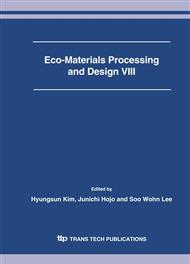p.447
p.451
p.455
p.459
p.463
p.467
p.471
p.475
p.479
Studies on Rheological Property and Miscibility of Lignosulfonate/Polystyrene Blends
Abstract:
Effects of amounts of lignosulfonate and additives and reaction temperature on thermoplastics of lignosulfonate/polystyrene blends were investigated by rheometer through measurement of maximal torque, balanced torque and plasticized time. Optimum experimental parameters for preparation of lignosulfonate/polystyrene blends with excellent thermoplastic properties were obtained. The results of SEM and IR revealed that miscibility of lignosulfonate/polystyrene blends was improved, favorable for development of degradable lignosulfonate-based materials.
Info:
Periodical:
Pages:
463-466
Citation:
Online since:
May 2007
Authors:
Keywords:
Price:
Сopyright:
© 2007 Trans Tech Publications Ltd. All Rights Reserved
Share:
Citation:


